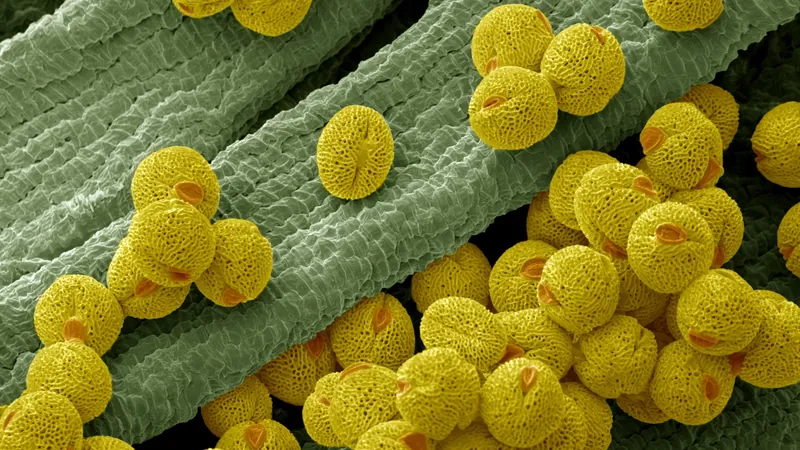
Revolutionizing Materials: How Pollen Could Transform Paper and Sponges
2025-09-01
Author: Wei
Pollen: The Surprising Key Behind Innovative Eco-Materials
At first glance, the lab of Nam-Joon Cho at Nanyang Technological University in Singapore appears to be like any regular research facility, bustling with scientists and machines. However, the vibrant orange-yellow stains on their lab coats reveal that something extraordinary is brewing within these walls.
Rather than focusing on the usual studies of pollen, which often relate to allergies or plant reproduction, Cho is on a groundbreaking mission. He spent the past ten years meticulously re-engineering pollen’s robust outer shell, known as sporopollenin—affectionately dubbed 'the diamond of the plant world'—into a gooey microgel.
Unlocking Nature's Hidden Potential
Cho believes this microgel could revolutionize the production of sustainable materials, paving the way for eco-friendly paper, films, and sponges. "Many dismiss pollen as mere dust, but it holds incredible potential if harnessed properly," he explains.
Joining Cho's vision, Noemi Csaba, a nanotechnology researcher from Spain, aims to utilize hollowed-out pollen shells as smart delivery systems for medications targeting the eyes, lungs, and stomach, acknowledging the immense possibilities that lie in this unique biomaterial.
Breaking Barriers: The Science Behind Pollen Transformation
To access pollen's properties, scientists first remove its sticky outer layer through a defatting process. This step is crucial for creating the empty capsules sought by Csaba. The real challenge has been cracking the tough shell, which previously limited its applications. A turning point came in 2020 when Cho’s team discovered that soaking pollen grains in an alkaline potassium hydroxide solution could transform their surface chemistry, allowing them to absorb water and become malleable like Play-Doh.
Before this treatment, the grains resembled hard marbles—sturdy but unyielding. Afterward, they became pliant and easily moldable, exponentially expanding their potential uses.
Innovative Applications of Pollen Microgel
When dried and cast in molds, the pollen microgel can morph into strong yet flexible sheets of paper or film that respond dynamically to environmental changes, such as pH and humidity. The unique properties of pollen-based films suggest promising future applications: smart devices that can react to their surroundings, wearable health monitors, and possibly even advanced materials for solar cells.
Cho’s research team asserts that pollen-derived paper could serve as a sustainable alternative to conventional paper, which typically depletes forests and consumes vast amounts of water—up to 13 liters for a single page. With pollen's abundance, particularly from sunflowers that produce tens of thousands of grains each summer, the environmental impact of harvesting this natural resource is far less damaging.
From Pollen to Practical Solutions
Beyond paper, freeze-dried pollen can be transformed into porous sponges with multiple applications—from scaffolding in tissue engineering to aiding in the absorption of oil spills or controlling bleeding.
Although the journey to market for pollen-based products is still ongoing, the research team's approach prioritizes sustainability without sacrificing ecological integrity. Unlike traditional biomaterials that often require destructive harvesting, pollen extraction does not harm the plants or flowers involved.
In a world increasingly seeking sustainable solutions, the revolutionary potential of pollen might just be the game changer we need.

 Brasil (PT)
Brasil (PT)
 Canada (EN)
Canada (EN)
 Chile (ES)
Chile (ES)
 Česko (CS)
Česko (CS)
 대한민국 (KO)
대한민국 (KO)
 España (ES)
España (ES)
 France (FR)
France (FR)
 Hong Kong (EN)
Hong Kong (EN)
 Italia (IT)
Italia (IT)
 日本 (JA)
日本 (JA)
 Magyarország (HU)
Magyarország (HU)
 Norge (NO)
Norge (NO)
 Polska (PL)
Polska (PL)
 Schweiz (DE)
Schweiz (DE)
 Singapore (EN)
Singapore (EN)
 Sverige (SV)
Sverige (SV)
 Suomi (FI)
Suomi (FI)
 Türkiye (TR)
Türkiye (TR)
 الإمارات العربية المتحدة (AR)
الإمارات العربية المتحدة (AR)